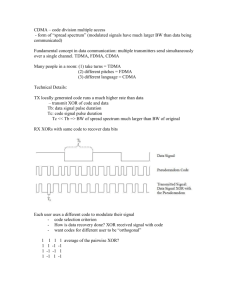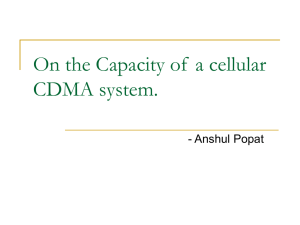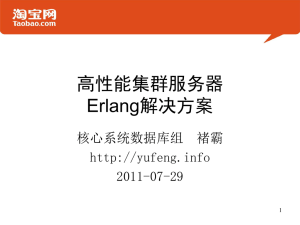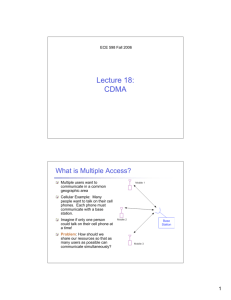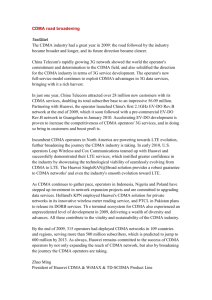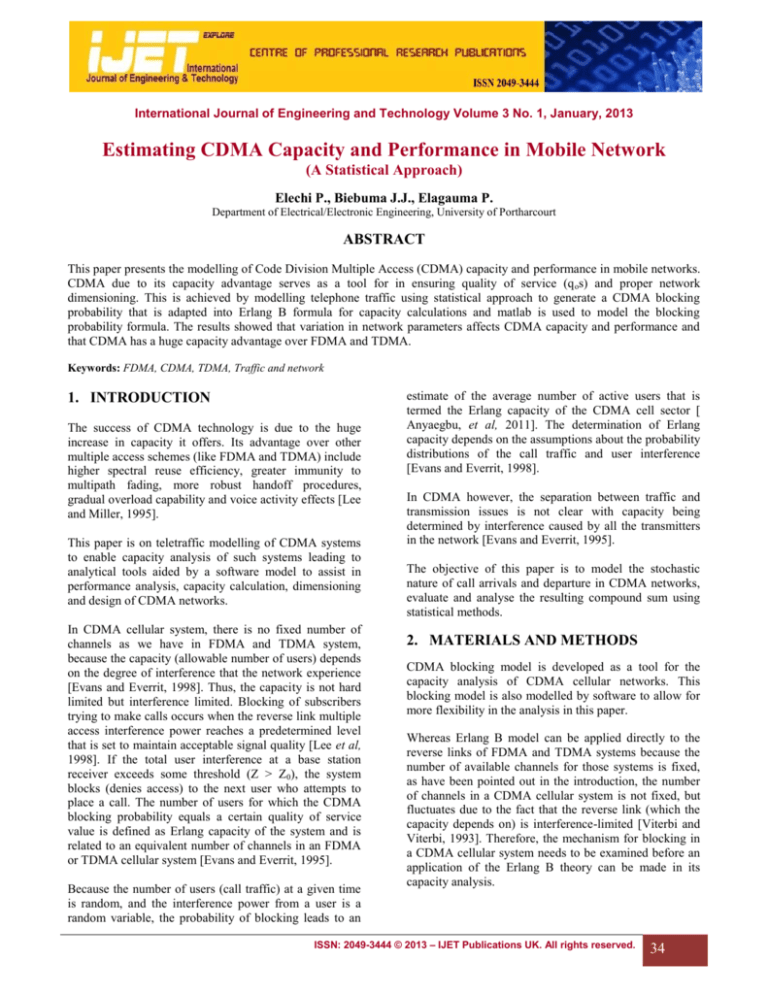
International Journal of Engineering and Technology Volume 3 No. 1, January, 2013
Estimating CDMA Capacity and Performance in Mobile Network
(A Statistical Approach)
Elechi P., Biebuma J.J., Elagauma P.
Department of Electrical/Electronic Engineering, University of Portharcourt
ABSTRACT
This paper presents the modelling of Code Division Multiple Access (CDMA) capacity and performance in mobile networks.
CDMA due to its capacity advantage serves as a tool for in ensuring quality of service (q os) and proper network
dimensioning. This is achieved by modelling telephone traffic using statistical approach to generate a CDMA blocking
probability that is adapted into Erlang B formula for capacity calculations and matlab is used to model the blocking
probability formula. The results showed that variation in network parameters affects CDMA capacity and performance and
that CDMA has a huge capacity advantage over FDMA and TDMA.
Keywords: FDMA, CDMA, TDMA, Traffic and network
1. INTRODUCTION
The success of CDMA technology is due to the huge
increase in capacity it offers. Its advantage over other
multiple access schemes (like FDMA and TDMA) include
higher spectral reuse efficiency, greater immunity to
multipath fading, more robust handoff procedures,
gradual overload capability and voice activity effects [Lee
and Miller, 1995].
This paper is on teletraffic modelling of CDMA systems
to enable capacity analysis of such systems leading to
analytical tools aided by a software model to assist in
performance analysis, capacity calculation, dimensioning
and design of CDMA networks.
In CDMA cellular system, there is no fixed number of
channels as we have in FDMA and TDMA system,
because the capacity (allowable number of users) depends
on the degree of interference that the network experience
[Evans and Everrit, 1998]. Thus, the capacity is not hard
limited but interference limited. Blocking of subscribers
trying to make calls occurs when the reverse link multiple
access interference power reaches a predetermined level
that is set to maintain acceptable signal quality [Lee et al,
1998]. If the total user interference at a base station
receiver exceeds some threshold (Z > Z0), the system
blocks (denies access) to the next user who attempts to
place a call. The number of users for which the CDMA
blocking probability equals a certain quality of service
value is defined as Erlang capacity of the system and is
related to an equivalent number of channels in an FDMA
or TDMA cellular system [Evans and Everrit, 1995].
Because the number of users (call traffic) at a given time
is random, and the interference power from a user is a
random variable, the probability of blocking leads to an
estimate of the average number of active users that is
termed the Erlang capacity of the CDMA cell sector [
Anyaegbu, et al, 2011]. The determination of Erlang
capacity depends on the assumptions about the probability
distributions of the call traffic and user interference
[Evans and Everrit, 1998].
In CDMA however, the separation between traffic and
transmission issues is not clear with capacity being
determined by interference caused by all the transmitters
in the network [Evans and Everrit, 1995].
The objective of this paper is to model the stochastic
nature of call arrivals and departure in CDMA networks,
evaluate and analyse the resulting compound sum using
statistical methods.
2. MATERIALS AND METHODS
CDMA blocking model is developed as a tool for the
capacity analysis of CDMA cellular networks. This
blocking model is also modelled by software to allow for
more flexibility in the analysis in this paper.
Whereas Erlang B model can be applied directly to the
reverse links of FDMA and TDMA systems because the
number of available channels for those systems is fixed,
as have been pointed out in the introduction, the number
of channels in a CDMA cellular system is not fixed, but
fluctuates due to the fact that the reverse link (which the
capacity depends on) is interference-limited [Viterbi and
Viterbi, 1993]. Therefore, the mechanism for blocking in
a CDMA cellular system needs to be examined before an
application of the Erlang B theory can be made in its
capacity analysis.
ISSN: 2049-3444 © 2013 – IJET Publications UK. All rights reserved.
34
International Journal of Engineering and Technology (IJET) – Volume 3 No. 1, January, 2013
Blocking occurs when the reverse link multiple access
interference power reaches a predetermined level that is
set to maintain acceptable signal quality. If the total user
interference at a base station receiver exceeds some
threshold, the system blocks (denies access to) the next
user who attempts to place a call [Evans and Everrit,
1995].
The number of users for which the CDMA blocking
probability, denoted BCDMA, equals a certain value
(usually 1 or 2%) is defined to be the Erlang capacity of
the system and is related to an equivalent number of
channels in an FDMA or TDMA cellular system. Thus,
the calculation of the CDMA blocking probability is
based on an analysis of the other-user interference.
Because the number of users (call traffic) at a given time
is random, and the interference power from a user is a
Random Variable, the probability of blocking leads to an
estimate of the average number of active users that is
termed the Erlang capacity of the CDMA cell or sector.
The determination of Erlang capacity depends on the
assumptions about the probability distributions of the call
traffic and user interference. In this paper, CDMA Erlang
capacities are determined using two different assumed
distributions for the total user interference power:
Gaussian (main focus) and lognormal approximations.
2.1 Formulation of the Blocking Probability
Considering a single, isolated CDMA cell with M active
users. The total reverse link signal-plus-noise power
received at the base station can be written as
αr1P1+ αr2P2+……+ αrMPM +
(N0W)c
(1)
M reverse link signals
noise power
Where {αri} are random variables representing the reverse
link voice activity, which have the experimental values
given as E{αri} =
= 0.4 and E{ }=
= 0.31,
are the random signal powers for the M active users. The
number of signals M is itself an RV, assumed to have a
Poisson distribution, so that E
=
To a potential (M + 1)st reverse link user, the total power
for the M active users and the thermal noise is
interference power. Thus, we may write
I
I′0W =
r1P1
+
r1P2
+…+
rMPM +
(N0W)c
Where
I′0 = I =
W
r1P1
+
r1P2
+…+
rMPM +
N0
(3)
W
is the power spectral density level for the total received
interference power.
Normalized by I′0Rb, where Rb is the data bit rate, the total
interference is characterized by the quantity
=
(4)
Where P=EbRb
=Z
distribution of the random variable Z, the probability that
the (M + 1) st mobile CDMA user will be blocked is the
probability that Z exceeds some threshold value Z0, as a
function of a threshold value of the interference parameter
η0
=Z+η
Z
(5)
(6)
If a probability density function pz(x) is known or
assumed for Z, then the evaluation of B CDMA is simply a
matter of integrating that pdf over the region defined by Z
> Z0:
(7)
BCDMA =
An`d
η
(2)
(thermal noise)
is a parameter indicating the loading of the CDMA system
and W/Rb is the spread-spectrum processing gain. Given
the value of η, the quality of the channel that is available
to the (M + 1) st mobile user is characterized by the value
of the random variable Z; if Z exceeds some threshold
value, then the channel is effectively unavailable
(blocked) to the (M + 1) st user. In terms of the
(8)
The exact pdf of Z is not known, however, so an
approximation is needed to compute BCDMA.
The CDMA blocking probability can be manipulated to
the form
ISSN: 2049-3444 © 2013 – IJET Publications UK. All rights reserved.
35
International Journal of Engineering and Technology (IJET) – Volume 3 No. 1, January, 2013
The median, mean, and mean square of ρi are assumed to
be same for all i and are obtained as follows:
BCDMA = Pr { Z > Z0 =
BCDMA =
(9)
= Pr {
>
Median
( 1 – η0) }
The approximation methods to be considered in what
follows are
Gaussian approximation: Based on the fact that Z is a
sum (Central Limit Theorem) we can write
Qz(x)
dt
ρ
Thus
(10)
E{ i} = E
BCDMA = Q
= ρmed E
Lognormal approximation: Based on the fact that the
SNRs in the sum are lognormal, Z itself can be
approximately characterized as a lognormal variable.
(16)
β
That is, the blocking probability can be calculated using
(11)
(15)
Mean
(17)
Where
E
(u) =
Thus
These approximation methods are based on identifying
the actual mean and variance of Z with the mean and
variance of a Gaussian RV and the mean and variance of a
lognormal RV, respectively. Next, we find the mean and
variance of Z and specify its relations to Gaussian and
lognormal RVs.
E{ρi} = ρmed MG (
(18)
Means square
E{
=E
=E
2.2 Mean and Variance of Z
=
The form of the interference statistics Z is the weighted
sum of the M RVs {ρi, i = 1, 2, …, M}:
Z=
=
+
+
+
(12)
Propagation measurements in general indicate that
received signal powers, when expressed in dB units, are
nearly Gaussian. Therefore, the {ρi} above, when
measured in dB units, are close to having a Gaussian
probability distribution with median mdB and standard
deviation σ dB:
ρ
= (eln10
Because M is analogous to the number of calls in progress
through a switch, which has a Poisson distribution, it is
reasonable to postulate that the mean and variance of M
are equal, as in the case of Poisson RV. The mean, mean
square and variance of Z therefore are
E{Z} = EM{E{Z|M}} = EM
= EM { M E{
E{
}} = E {M} E {
}
}=
(20)
E {Z2} = EM { E{Z2 | M }} = EM {
= EM
ρ
= eβ(mdB+σdBGi), using β = (In 10)/10
(19)
(13)
Therefore, the RV ρi is lognormal and can be written
ρi =
MG (2
= ρ2med
=
=
ρi = mdB +σdBGi, Gi = G(0, 1)
(dB) = 10
=
(14)
=EM
=
[E{
ISSN: 2049-3444 © 2013 – IJET Publications UK. All rights reserved.
(21)
36
International Journal of Engineering and Technology (IJET) – Volume 3 No. 1, January, 2013
Z2
2
2.4 CDMA Blocking Probability Formula for
Gaussian Assumptions
Under the Gaussian assumption, the mean and variance of
Z are identified as the mean and variance of a Gaussian
RV, mM + σMG:
BCDMA = Pr{Z>Z0}
Pr{mM + σ MG > Z0}
The interference due to mobiles in other cells can be
accounted for by using first- and second-order frequency
reuse factors F = 1 + ξ and F1 = 1 + ξ1, respectively,
where
And
(23)
= Pr{ G >
σ
}=σ
(27)
Substituting the expressions for the mean and variance of
Z, we obtain a general expression for the CDMA blocking
probability under the Gaussian approximation for the
interference statistic, given by
BCMDA = Q
(28)
In which the the Erlang capacity is
.
A typical analytical value of ξ1 = 0.086 and ξ= ξ1 = 0.55.
The interference parameter η is related to cell loading
parameter by the relation
With this method of accounting for interference from
other cells, the mean and variance for Z becomes
(29)
Thus the threshold
threshold as X0=1- .
E {Z} =
can be converted to loading
Using typical numerical values for the parameters with
the following set of values [Jhong S. L. et al, 1998]:
and Var {Z} =
2.3 Approximations for
Distribution of Z
the
Probability
Because the M RVs {ρi, i=1, 2,…, M} are lognormal RV,
the interference statistic Z is the weighted sum of
lognormal RVs. One approximation for the distribution of
Z is based on assuming that the summing of variables to
produce Z causes its distribution to converge to a
Gaussian distribution according to the CLT. Another
approach is to assume that the lognormal character of the
{ρi} makes Z
have an approximately lognormal
distribution. Thus:
=2.5dB;
=7dB; W=1.2288MH;
Rb=9.6kbps; X0= 0.9;
=0.4;
=0.31;
β = (In 10)/10,
The BCDMA can be reduced to
BCDMA = Q
(30)
This is the blocking probability of CDMA network as a
function of Erlang capacity
can assume typical
experimental values such as
=0.55.
Z =
=
+
2.5 CDMA Blocking Probability Formula for
Lognormal Assumptions
Gaussian approximation
Lognormal approximation
(26)
Under lognormal assumption, the mean and variance of Z
are identified as the mean and variance of lognormal RV,
ζ, where
ISSN: 2049-3444 © 2013 – IJET Publications UK. All rights reserved.
37
International Journal of Engineering and Technology (IJET) – Volume 3 No. 1, January, 2013
The solution is
ζ =
(31)
(35)
The mean, mean square, and variance of ζ are given by
E{ζ}=
(32)
And
E {ζ2} =
(36)
1/2
Var { ζ } = E {ζ2} – [E{ζ}]2 =
(33)
By setting E{Z} = E{ ζ } and Var{Z} = Var{ ζ }, where
the mean and variance of Z are given in (23) and (24).
We solve for mM and σ2M:
Using these parameters, the blocking probability formula
for the lognormal approximation is
BCDMA = Pr{Z > ZO} ≈ Pr{
(37)
Z0 }=Q
Substituting the expressions for mM and σM, we obtain
general expressions for the CDMA blocking probability
under the lognormal approximation for the interference
statistic, given by
And
(34)
BCDMA = Q
(38)
in which the Erlang capacity is
. Because the
interference parameter η is η = 1 – X, we may convert the
threshold η0 into a loading threshold X0 = 1 – η0.
probabilities derived is expressed as a function of the
interference parameter threshold η0 and the cell loading
threshold X0.
Thus with this, we have derived Erlang capacity formulas
for CDMA cellular system under two separate
approximations for the interference statistic: Gaussian
approximation, by invoking the CLT, and lognormal
approximations, on the assumption that the sum of M
lognormal RVs is also a lognormal RV. The blocking
The blocking probabilities will be plotted as a function of
Erlang capacity
parametric in median values of
=Eb/N0 taking values of 5, 6, and 7dB. Plots showing
other variants will also be taken to provide ingredients for
analysis.
3. RESULTS
Figure 1 CDMA blocking probability (Gaussian approximation) versus average number of mobile users, SNR requirement varied
ISSN: 2049-3444 © 2013 – IJET Publications UK. All rights reserved.
38
International Journal of Engineering and Technology (IJET) – Volume 3 No. 1, January, 2013
Figure 2 CDMA blocking probability (Gaussian approximation) versus average number of mobile users,
loading threshold varied
Figure 3 CDMA blocking probability (Gaussian approximation) versus average number of mobile users,
reuse fractions varied
ISSN: 2049-3444 © 2013 – IJET Publications UK. All rights reserved.
39
International Journal of Engineering and Technology (IJET) – Volume 3 No. 1, January, 2013
Figure 4 CDMA blocking probability (lognormal approximation) versus average number of mobile users, SNR requirement varied.
ISSN: 2049-3444 © 2013 – IJET Publications UK. All rights reserved.
40
International Journal of Engineering and Technology (IJET) – Volume 3 No. 1, January, 2013
Figure 5 CDMA blocking probability (lognormal approximation) versus average number of mobile users, loading threshold varied.
Figure 6 CDMA blocking probability (lognormal approximation) versus average number of mobile users, reuse fraction varied.
4. DISCUSSION
4.1 Graphical Plots and Analysis of CDMA
Blocking Probability Formula for
Gaussian Assumptions
Using (28), we take a plot of B CDMA versus
cell (
and for multiple cells
and the following typical parameter values:
=2.5dB;
0.9;
=0.4;
for a single
=0.55)
=7dB; W=1.2288MH; Rb=9.6kbps; X0=
=0.31
The plots are parametric in
the values 5,6 and 7dB
, which takes
We observe that the value of Eb/N0 needed for link
operations affects the average number of users that can be
accommodated at a given level of blocking. Raising the
Eb/N0 requirement increases the blocking probability for
the same value of M or decreases the capacity for the
same probability. For example, when the blocking
probability is chosen to be BCDMA = 10 -2 = 0.01 = 1%,
Figure 1 shows for multiple cells that the corresponding
value of the Erlang capacity M is 18 for mdB = 7 dB, 24
for mdB = 6dB, and 33 for mdB = 5 dB.
If we denote the Erlang capacity for a single cell by c
and the capacity for multiple cells by , for BCDMA =
1.0% and Eb/N0 = 6 dB, we then read from figure 1 that
= 24.1. The ratio of these values is
c = 37.5 and
37.5/24.1 = 1.56, a value that is approximately equal to
the assumed value of the reuse factor, F = 1 + ξ = 1.55.
This is consistent with the definition of the reuse factor.
Assuming that mdB = Eb / N0 = 6 dB, the effect of varying
the loading threshold X0 on BCDMA and
is illustrated in
Figure 2, in which X0 takes the values X0 = 0.66, 0.75,
and 0.9. These values correspond to the multiple access
interference power being twice, three times, and nine
times as strong as the thermal noise. Raising the loading
threshold has the effect of relaxing the system
requirements, and is seen in Figure 2 to result in either a
decrease in the blocking probability for the same value of
, or an increase in for the same value of BCDMA. If we
substitute specific numerical parameter values into the
general expression (28), such as σdB = 2.5 dB, mdB = 7dB,
W = 1.2288 MHz, Rb = 9.6kbps, X0 = 0.9,
= 0.4,
=
0.31, and we obtain
BCDMA =
Q
ISSN: 2049-3444 © 2013 – IJET Publications UK. All rights reserved.
(39)
41
International Journal of Engineering and Technology (IJET) – Volume 3 No. 1, January, 2013
Because Q(0) = 0.5, we infer from (39) that the blocking
probability is 50% when
= a/b. This high a blocking
probability is of course unacceptable, so we know that an
acceptable value of blocking probability is realized only
when is much less than a/b. It is interesting therefore to
note by comparing (28) and (39) that the upper limit on
based on having a small blocking probability is
(40)
The ideal CDMA capacity was shown as
M=
(41)
which is valid under perfect power control and
omnidirectional cell antenna assumptions. Note that under
the conditions of perfect power control (σ dB = 0 dB) and
100% cell loading in the ideal situation (X0 = 1), then the
Erlang capacity bound in (40) is equal to the ideal
capacity in (41).
4.2 Sensitivity To ξ′
The sensitivity of the CDMA blocking probability to the
value of the “second order” reuse fraction ξ is considered
in Figure 3, in which ξ = 0.55 and E b / N0 = 5, 6, and 7
dB. The BCDMA versus M curves for ξ′ = 0.55 are seen to
be slightly to the left of those for ξ′ = 0.086 for small
blocking probabilities. This indicates that the terms in the
analysis that involve the mean square power are not
critical and that use of assumption that ξ ′ = ξ does not
incur a significant loss in accuracy, provided that the
blocking probability is taken to be greater than 1%.
4.3 Graphical Plots and Analysis of CDMA
Blocking Probability Formula for
Lognormal Assumptions
Plots of equation (38) for BCDMA versus are shown in
Figure 4 for a single cell (ξ = ξ′ = 0) and for multiple cells,
using ξ = ξ′ = 0.55 and the parameter values σdB = 2.5dB,
W = 1.2288 MHz, Rb = 9.6 kbps, X0 = 0.9,
= 0.4, and
= 0.31. The plots are parametric in mdB = Eb / N0,
which takes the values 5, 6, and 7 dB.
As for the Gaussian approximation in Figure 1, we
observe that the value of Eb /N0 needed for link operations
greatly affects the value of for a given value of BCDMA .
The higher the Eb/N0, the lower the
value, for given
blocking probability. For example, when BCDMA= 10-2 =
0.01 = 1%, figure 4 shows for multiple cells that the
corresponding value of the Erlang capacity is 16 for Eb
/N0 = 7dB, 22 for Eb /N0 = 6dB, and 29 for Eb /N0 = 5
dB.
In Figure 5, the cell loading threshold Xo is varied for the
lognormal approximation and the case of Eb/N0 = 6dB.
Again we see that raising or lowering X0 has a significant
effect on the Erlang capacity for a given value of the
blocking probability. The amount of increase or decrease
in Erlang capacity is greater than the amount of increase
or decrease in Xo. For example, raising Xo by 20% from
0.75 to 0.90 increases the value of Erlang capacity at
BCDMA= 1% from about 16 to 22, or about 35%, indicating
the high sensitivity of the Erlang capacity to the cell
loading. Therefore, the threshold value of cell loading
should be chosen very carefully. The sensitivity of the
CDMA blocking probability to the value of the secondorder reuse fraction under the lognormal approximation
is shown in Figure 6, in which the first order reuse
fraction = 0.55 and Eb /N0 = 5,6, and 7dB are used.
4.4 Erlang Capacity Comparisons of CDMA,
FDMA, AND TDMA
Having found the equivalent number of channels in a
CDMA system that corresponds to a value of blocking
probability, we can now compare the capacities of
CDMA, FDMA, and TDMA cellular systems. The Erlang
capacities and equivalent values of
were read from the
curves in the Figure 3, for the case of (ξ, ξ ′) = (0.55,
0.086), and the values of N are based on the Erlang B
table. For example, for Eb/N0 = 7 dB and B = BCDMA =
1%, from Figure 3, we read the Erlang capacity
= 20
Erlangs. Now, for
= A, the offered load, we need to
find the equivalent number of channels N that satisfies
(41). The number of channels in Erlang B table is for a
CDMA cellular system in one 1.25-MHz band (one
Frequency Assignment). Assuming a noncontiguous 12.5MHz cellular band, the CDMA system can use as many as
nine 1.25-MHz FAs.
Thus, to compare the effective number of CDMA
channels available in a particular sector with the number
of channels available in the AMPS (FDMA) and TDMA
(IS-54) cellular systems; the numbers for N must be
multiplied by the number of FAs, which is nine. After this
multiplication is done, the corresponding Erlang capacity
can be obtained from an Erlang B Table or calculation by
identifying the offered load with a multi-FA CDMA
Erlang capacity denoted by Mmulti-FA. Let us consider a
numerical example. For BCDMA = 1%, ξ = 0.55, ξ′ = 0.086,
ISSN: 2049-3444 © 2013 – IJET Publications UK. All rights reserved.
42
International Journal of Engineering and Technology (IJET) – Volume 3 No. 1, January, 2013
and Eb / N0 = 7 dB, we have N = 30 from Erlang table.
Thus, the effective number of CDMA channels in a 9-FA
system is N1 = 30 x 9 = 270. We now need to find the
offered load A = Ṁmulti-FA corresponding to N1 = 270 and
1% blocking. The offered load giving this numerical
value according to the Erlang B table, with Ṁ replaced by
Ṁmulti-FA, is calculated to be 248 Erlangs. The offered
load for an AMPS sector, which supports 19 channels,
gives 12.3 Erlangs for a blocking probability of 2%, as
shown in Erlang B table. For a single sector of an IS-54
TDMA system, which supports 19 x 3 = 57 channels,
gives 46.8 Erlangs for the identical blocking probability
of 1%. Thus, using the notation of MCDMA Ṁmulti-FA, the
ratios of Erlang capacities are computed to be
Comparative capacity analysis showed that CDMA has a
huge capacity advantage over TDMA and FDMA.
RECOMMENDATION
The following recommendation can make the work in this
paper of immense practical usefulness. The model can be
built into a handheld instrument that can be readily usable
by network operators for planning and design.
REFERENCES
[1] Viterbi, A.M. and Viterbi, A.J. (1993): Erlang
capacity of a power controlled CDMA system. IEEE
J. Select. Areas communication. (11): 892-900.
(CDMA advantage over AMPS) (42)
(CDMA advantage over IS-54) (43)
Therefore, over a 12.5MHz band with nine FAs, the total
number of Erlangs of traffic that a CDMA sector can
service is over twenty times that of an AMPS (FDMA)
sector and over five times that of an IS-54 (TDMA)
sector.
To obtain this gain in capacity, however, requires careful
implementation of sound engineering design principles
peculiar to the spread-spectrum waveform techniques that
are employed by the CDMA system.
[2] Evans, J.S. and Everrit, D. (1995): Teletraffic
capacity of CDMA Cellular networks Department of
Computer Engineering and Computer Science,
University of California, Berkelay, CA, 94720, USA,
49-52
[3] Lee, J.S. and Miller, L.E. (1995): Erlang Capacity of
CDMA cellular systems. In proc. GLOBECOM’95,
Singapore, 1877-1883.
[4] Evans, J.S. and Everitt, D. (1998) Effective
bandwidth based admission control for multiservice
CDMA cellular networks: Department of Computer
Engineering and Computer Science, University of
California, Berkelay, CA,94720, USA, 33-46.
5. CONCLUSION
The stochastic nature of call arrivals and departures were
characterized using statistical means. Blocking occurred
when the reverse link multiple access interference power
reached a predetermined level that is set to maintain
acceptable signal quality. When the total user interference
at a base station receiver exceeded the set threshold, the
system blocked the next user attempting to place a call.
The number of users for which the CDMA blocking
probability equaled 1% as chosen was taken to be the
Erlang capacity of the network. Thus, a new CDMA
blocking probability model is developed that enabled the
estimation and analysis of Erlang capacity of CDMA
networks. Graphic results for the blocking model
generated showed the effect of variations in interference
parameters on CDMA capacity. The Erlang capacity
from the model was adapted into Erlang B formula to
estimate capacity in terms of channels, and the number of
subscribers a typical CDMA sector could accommodate.
[5] Jhong S. L., Fapojuwo, A.O. and Lee, S.Y. (1998):
CDMA systems Engineering Handbook. Artech
House mobile communications Library: 43-54.
[6] Lee, J.S., Evans, J.S. and Everitt, D. (1998): Analysis
of reverse link traffic capacity for cellular mobile
communication networks employing code division
multiple
access,
in
Proc.
Australian
Telecommunication Networks and Applications
Conference, Melbourne, Australia, 775-780.
[7] Lee, J.S. and Miller, L.E. (1995): CDMA systems
Engineering Handbook, Library of Congress
Cataloging-in-Publication Data: 142-146.
[8] Anyaegbu, A., Dike, J.N. and Elagauma, P. (2011):
Traffic comparison of CDMA and FDMA on Cellular
Network, Continental journals of Engineering
Science 6 (3): 15-17.
ISSN: 2049-3444 © 2013 – IJET Publications UK. All rights reserved.
43

